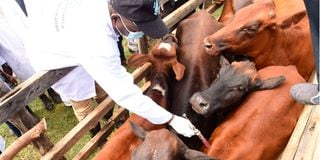Premium
Can Kenya vaccinate all livestock? Expert weighs feasibility, challenges

Cows being vaccinated against foot and mouth disease in Emining in Baringo County on June 26, 2020.
What you need to know:
- Readers wanted to know whether it is technically possible to vaccinate every animal in the country.
- A total of 22 million head of cattle and 50 million sheep and goats are supposed to be vaccinated.
Last week, I shared an article on the claimed livestock vaccination programme in Kenya. Readers from various backgrounds contacted me with numerous questions and compliments.
The majority of readers wanted to know whether it is technically possible to vaccinate every animal in the country. Another frequent question was whether, to control diseases, a nation needed to vaccinate each animal individually and with which vaccines.
I thank all the readers of this column and wish you a happy New Year. It has been seven years since we began engaging with you. I appreciate the feedback you provide to help us communicate better.
Starting with the first question, I can state without fear of contradiction that it is not possible to vaccinate all the animals in the country. In the case of the vaccination announced by President William Ruto on November 8, 2024, a total of 22 million head of cattle and 50 million sheep and goats are supposed to be vaccinated. This is roughly the total population of cattle, sheep, and goats in the country.
There are five main reasons why it is not possible to vaccinate all the livestock in the country. The first is that the population census itself is not accurate, and the total population given is an estimate. Some animals may be missed during the counting because they may not have been available or accessible.
The second reason is that some animals were not born at the time of vaccination and would only be vaccinated during the next vaccination campaign. Third, animals may be moved from one area where vaccination has not been done to another where animals are vaccinated.
Animals may also fail to be vaccinated because they may have been sick at the time of vaccination. Sick animals are not vaccinated because their immunity may be low, making them fail to produce enough immunity, or the vaccine may be incompatible with the treatment being given for their illness.
Vaccination may finally fail to be given to some animals because the disease being vaccinated against does not exist in a particular area. For instance, Rift Valley fever in Kenya is known to occur in specific areas and mainly during periods of heavier-than-normal rainfall. The disease is therefore vaccinated against when heavy rains are expected.
The second question is more complicated to answer. Scientific research shows that a country does not need to vaccinate all animals to control diseases. However, different diseases require different proportions of the population to be vaccinated to fully control them.
It is known that at least 70 per cent of the cattle population should be vaccinated to control diseases. Further, to eradicate a disease, animals must be vaccinated diligently for three to five years at a minimum of 70 per cent of the population.
When animals are vaccinated, they build up immunity against specific diseases. Some disease organisms elicit immunity for short periods, while others provide immunity for a year or more. This duration of protective immunity determines how often animals should be vaccinated for specific diseases.
For instance, foot and mouth disease vaccine evokes immunity in cattle, sheep, and goats that lasts for six months. Animals are therefore vaccinated twice per year to remain protected.
My experience is that when booster vaccination is delayed by about a month, animals start getting infected with the disease. In areas with very heavy infection challenges, it is recommended that animals be vaccinated in the fourth or fifth month after the last vaccination.
Some farmers have asked why they sometimes do not revaccinate against foot and mouth disease but the animals remain uninfected for a full year. The answer is that for an animal to get infected, there must be a virus circulating in the animal’s environment and in large enough quantities to cause infection.
When 70 per cent of the animals in the population are vaccinated twice per year for three to five years, the virus in most cases dies out due to the lack of a susceptible host where it could multiply, cause disease, and produce viral particles to maintain the disease in the environment.
Foot and mouth disease affects cattle, sheep, goats, and pigs. Therefore, to eradicate the disease, all these species should be vaccinated routinely. If not, the disease may be maintained in the species that has not been vaccinated.
The main diseases that cattle, sheep, and goats are vaccinated against are foot and mouth disease, anthrax, and black quarter. In addition, cattle are given lumpy skin disease vaccines once per year.
Anthrax and black quarter vaccines are given once per year, except where the disease challenge is very high, and then the vaccines can be administered twice per year.
In addition to the vaccines common to cattle, sheep and goats are also given goat and sheep pox vaccines, similar to the lumpy skin disease vaccine, once per year. Other vaccines given to sheep, goats, and cattle depend on the diseases found in the area or country where the animals are kept. In Kenya, for instance, the peste des petits ruminants (PPR) vaccine is given to sheep and goats mainly in arid and semi-arid lands and some highland areas where it occurs.
Diseases have been eradicated in both human and animal populations through diligent vaccination. Classical examples of such eradication are smallpox in humans and rinderpest in cattle, both eradicated through diligent vaccination globally.
Covid-19 is another disease whose control in humans using vaccines is still fresh in the minds of many people. Although there were many queries and worries about the Covid-19 vaccine’s safety and effectiveness, it was clear that vaccination played a key role in putting the disease under strict control.
It is, however, important for everyone to know that vaccines may be very effective in controlling and eradicating diseases, but they account for only about 20 per cent of the cost of executing livestock vaccination in Kenya.
The balance and bulk of the vaccination cost is taken up by support activities, including vaccine distribution and delivery logistics, vaccination staff, and stakeholder engagement, especially with animal owners.
Vaccination is best done as a mass activity to minimise costs, wastage, and time loss.





